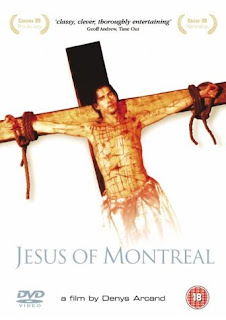Okay… so I’ve seen it now and will never be able to scrub the memory of this facile piece of junk from my mind. The fourth Omen film was a TV movie (that managed to get a theatrical release in the UK and Australia, somehow) made in 1991. It tied itself into the other films with the name Damien Thorn but it also missed a lot out. It was directed by Dominique Othenin-Girard who walked out during production to be replaced by Jorge Montesi.
Now I had heard a lot about this being about the return of the antichrist (Damien having been killed at the end of the third film) in the form of a girl – named Delia (Asia Vieira) – in actual fact this is most definitely not the case. Delia is not the antichrist… what she is, is… well that would be a huge spoiler and I do intend to spoil it, but not just yet. After all, if you haven’t seen it and I do spoil it, I may save you the pain of watching it.
 |
| adoption |
So we start with the adoption of a baby by the Yorks, Karen (Faye Grant) and Gene (Michael Woods). She is a successful attorney (he may be as well but he is about to turn to politics) and whilst they are both fertile they haven’t been able to have kids. The nuns at the orphanage tell them that the baby’s parents were at college together (this of course is a lie that we will unravel later). Once the new parents have left the younger nun (Megan Leitch) goes bonkers, whilst the older one has a heart attack. During this we discover that the older one thought it more of a sin to kill a child, despite knowing whence it came from.
 |
| Kirlian photography |
So we get the growing up of Delia, her father becoming an honest politician (really, he is painted whiter than white all the way through) and Karen becoming more and more distrustful of the child. During this we see them adopt a Rottweiler after it save Delia from being squished by a truck, her behaviour in school becomes more and more errant and the priest who baptised her manages to be killed by satanic powers. They get a new age nanny who sees her healing crystals turn black and a kirlian photo shows Delia to have a murky mess of an aura.
 |
| infernal choir |
Eventually, when Delia reaches the age of eight, a suddenly pregnant Karen hires a private eye (Michael Lerner) to uncover the truth about her daughter… this he does, discovering that the listed parents were just names of two people who died in the thirties, that sister Yvonne (the younger nun) turned prostitute and then snake handling prophetess and he gets the father’s name (if he got the mothers then it wasn’t mentioned in film). Following posting his findings he sees a nativity scene turn evil, a Christmas choir become a demonic choir singing the omen theme (which was seriously one of the worst bits of the movie) and is killed by a possessed wrecking ball.
 |
| Delia... not the antichrist |
So, who were Delia’s parents and is she the antichrist? We discover her father was Damien Thorn… we will ignore the roughly 9 year gap (there is nothing in this that offers a date and so, at a push, it might be 1983 rather than 1991). There is some conjecture online that Kate Reynolds was the mother but no reason to suppose this other than the fact that Reynolds and Thorn slept together in The Final Conflict. Delia, however, is not the antichrist. She does talk about being told things by her father (whether she referred to the devil or the antichrist is not established) but the antichrist is mostly referred to (in film) in the masculine. The question is asked once as to whether the antichrist could be female.
 |
| 666 |
We discover also that Delia carried her twin in her body in such a way that the foetus was viable. During the film there is a horse accident and she is hospitalised. The satanic doctor (Madison Mason) admits that he extracted the foetus at this point and subsequently implanted it into Karen (how this occurred with no physical trace on her body is not gone into and we must suppose that her body accepting the foetus was supernaturally aided). The son, Alexander, is the antichrist – indeed when Delia suggests to Karen that she really see him there is the 666 birthmark in his palm.
 |
| dead nanny |
Piffle… absolute piffle. Beyond in film issues and the dating problems perhaps inherent in the film, there is also the fact that the film overlooks the fact that there had been the second coming of Christ in the third film – something the world would have noticed, one feels. The acting is about what you’d expect from a TV movie, the character Delia is drawn as sociopathic and nasty – rather than charming and insinuating as one would expect. It is just a bad old way to end the series.
If I was you I’d pretend it never happened. I, however, will now turn my attention to the 2006 remake of the first film but, in the meantime, The Awakening’s imdb page is
here.























